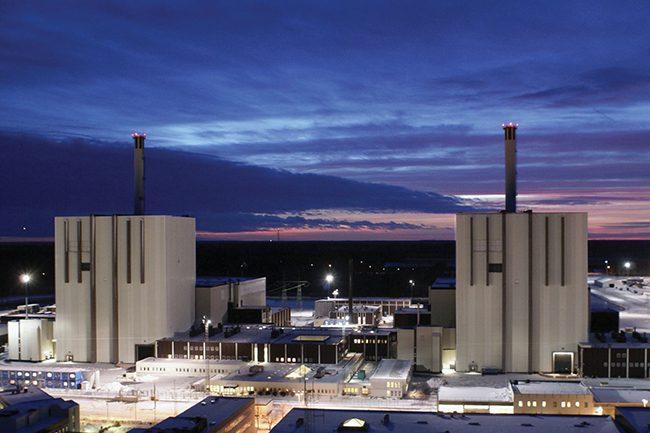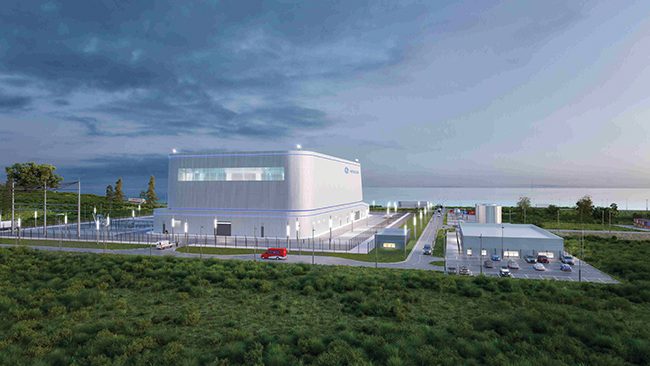10 New Reactors Discussed as Sweden Looks to Expand Nuclear Power
Sweden has joined the growing list of countries discussing nuclear power as part of a strategy to produce more electricity while also decarbonizing power generation. Lawmakers in June adopted new targets as part of their energy plans, looking at fossil-free and renewable energy to help meet power demand pegged at about 300 TWh by 2040. The country also wants to reach net-zero carbon emissions from the power sector by 2045.
The strategy includes building more nuclear reactors—as many as 10 units have been discussed—a departure from Sweden’s previous stance, as the country voted in 1980 to phase out nuclear power. Later government moves enabled some reactors to continue operating, and a new government coalition has said nuclear power is essential to meet decarbonization goals while also increasing the electricity supply. Lawmakers, in an effort to spur development of new projects, have said the government will help finance new nuclear power plants to support their construction.
“Sweden and the rest of Europe will not meet their energy transition goals unless a substantial increase in nuclear power is part of the diversified energy mix,” said Seth Grae, CEO of Lightbridge, a U.S.-based nuclear fuel technology development company. Grae told POWER, “Now is the time to get going on deploying new nuclear energy capacity.”
Swedish officials also said the country could lift its ban on mining for uranium as part of the efforts to support nuclear power. Sweden accounts for about 80% of the European Union’s uranium deposits. The country currently extracts uranium as a byproduct during the mining of other metals. Finance Minister Elisabeth Svantesson, in a recent address to the country’s parliament, said of the government’s moves, “This creates the conditions for nuclear power. We need more electricity production, we need clean electricity, and we need a stable energy system.”
 |
|
1. The Forsmark nuclear power plant, shown here, has three boiling water reactors and produces about one-sixth of Sweden’s electricity. The units, with total generation capacity of about 3,300 MW, were commissioned between 1980 and 1985. Sweden has six operating nuclear reactors, including two at the Ringhals plant, and one at Oskarshamn. Courtesy: Vattenfall |
Sweden at present receives about 98% of its power from nuclear, wind, and hydro. There are currently six reactors in operation at three sites (Figure 1). Mariano Grossi, director general of the International Atomic Energy Agency (IAEA), speaking in late August during an official visit to Sweden, said, “For more than half a century, Sweden has been one of the leaders internationally when it comes to nuclear technology. It is now taking steps to facilitate a new expansion phase to meet an anticipated rapid growth in the demand for electricity to power its economy. It is a frontrunner in the clean energy transition, already relying almost exclusively on nuclear, hydro, and renewables for its energy needs.”
Grossi, who met with officials in Stockholm in his first visit to Sweden since taking office four years ago, said, “My discussions in Stockholm with senior government, regulatory, and industry officials have demonstrated a shared understanding that the world needs more nuclear energy to be able to fight the climate crisis effectively. Reliably generating dispatchable power 24/7, nuclear is an ideal partner to wind and solar. The IAEA is following developments in Sweden with great interest and stands ready to provide any support that may be requested. I’m very encouraged by what I’m seeing here.”
Nuclear power provided about 30% of Sweden’s electricity last year. Officials in promoting nuclear power have said the technology will count toward the country’s goal of producing all its energy from renewable resources by 2045. “Sweden is looking to double its electricity production while cutting down on fossil fuels. The only way that plan can work is another source of energy is easily available and is both bountiful and efficient enough to effectively substitute for LNG [liquefied natural gas] or oil. Nuclear is the only form of energy that can meet that level of demand in the foreseeable couple of decades,” said Irina Tsukerman, president of Scarab Rising and a geopolitical analyst. Tsukerman also said the use of domestically produced uranium as fuel will be important, telling POWER, “The plan on lifting the ban on mining uranium is pragmatic and necessary to meet the volume of nuclear energy demand arising from this plan.”
Jerrold Vincent, co-founder of U.S.-based Nuclearn.ai, a group working on artificial intelligence for the nuclear industry, told POWER it’s not surprising Sweden wants to expand its nuclear power fleet. “With its large clean power generation capacity, nuclear power is an important part of a diversified, economical, and sustainable clean energy mix,” said Vincent. “Technological progress in advanced reactor design, small modular reactors [SMRs], and improvements in administrative operations using artificial intelligence are continually driving down costs while improving safety.”
Vattenfall, Sweden’s state-owned utility, has said it is looking at building at least two SMRs, and is prepared to extend the operating life of the country’s existing reactors as part of the nuclear-focused strategy. Anna Borg, Vattenfall’s CEO, said the SMRs could be built near the Ringhals nuclear power plant, while noting that “all fossil-free energy types will be needed to meet the increasing demand for electricity in Sweden.”
Vincent also reiterated that support for domestic mining of uranium will be important. “Sweden has the largest quantity of uranium deposits in Europe, presenting a unique opportunity to insulate themselves from other fuel sources whose price and availability have been affected by recent geopolitical instability,” he said. “There’s no serious conversation about the future of clean energy that doesn’t involve nuclear—and Sweden is uniquely well-suited to take advantage.”
Scott Holcombe, vice president of engineering for Lightbridge, told POWER, “Sweden has been a strong nuclear power country for decades without mining their local uranium,” but noted that “having a domestic supply of uranium would be beneficial for any country’s domestic nuclear industry.” Holcombe, formerly a nuclear fuel performance engineer for the Tennessee Valley Authority, said it’s likely Sweden would look for reactor technologies from the U.S., France, and South Korea. “Sweden is in the process of joining NATO; reactors from Russia or China are at a strong disadvantage compared to other reactor vendors,” he said. “I believe the utilities must follow any applicable national and EU [European Union] capital investment regulations and go through a normal bid process where they consider reactors from several reactor vendors before they select the final candidate(s).”
W.A. “Art” Wharton III, a nuclear professional, and CEO and president of Studsvik Scandpower, a Swedish nuclear reactor software analysis company, told POWER, “The timing of Sweden’s reversal of four decades of poor nuclear policy coincided with Russia’s invasion of Ukraine. As the Swedes grapple with the realities of providing a robust and reliable electricity and district heating supply, their need to replenish the retiring nuclear fleet became clear and unambiguous once it became apparent that it could not be made up with more hydro, wind, or solar. Relying on nuclear energy provides Sweden with the most energy independence and robust and reliable supply of energy for the changing world dynamics.”
 |
|
2. There is growing global interest in GE Hitachi Nuclear Energy’s (GEH’s) BWRX-300 small modular reactor (SMR) design. GEH said it has memoranda of understanding or other agreements in place with companies in Canada, Poland, UK, U.S., and Sweden, among others. Courtesy: GEH |
Wharton continued, “Sweden is a very practical nation and will likely look toward newer LWR (light water reactor) technologies including large and small modular reactors, but the recent focus appears to be on SMRs. One recent partnership of note is Kärnfull Next with GE Hitachi for the potential to build BWRX-300 units [Figure 2] at the Studsvik site. Additionally, they have new reactor technology companies in Sweden including Blykalla [literal translation: “lead cold”] which is developing a Gen IV reactor using molten lead coolant. U.S. nuclear companies have a strong footprint in Sweden, so they’ll likely be involved in one or more of the projects.”
Wharton, who prior to joining Studsvik Scandpower worked at nuclear giant Westinghouse Electric Co. for more than a decade, said, “The grid in Sweden is deregulated since 1996, but electricity prices are high right now. For long-term capital investments such as nuclear power plants, surety of price will be a key factor for investors.” Grae told POWER, “Generally, private investors are interested only if there is significant government support. There could be a possibility of vendor financing for part of the cost, and perhaps support from the export credit agency in the vendor country.”
Wharton said several factors could impact Sweden’s timeline to build new reactors. He told POWER, “The industrial capabilities of Sweden are highly developed, but their regulator SSM [Swedish Radiation Safety Authority] does not have a lot of staff for full reviews of licenses. The job market for nuclear-experienced engineers in Sweden has also been relatively flat for multiple decades, so I’d expect a 10-year horizon with human resources being the main limiting factor to get up and running.”
Holcombe agreed, saying, “I am not aware of any conditions in Sweden that would lead to an expectation of a different timeline for new reactors as compared to other Western countries, so the timeline could be similar to other countries deploying western-designed reactors.”
Said Grae: “Utilizing the same team to deploy a similar plant would most likely give greater assurance as to the timeline. Commercial operation within 10 years could be reasonable, with construction time of five years if the reactor vendor and EPC [engineering, procurement, and construction] firm have deployed a similar unit recently.”
Grossi, in his recent meeting with Swedish officials including SSM Director General Michael Knochenhauer, said the IAEA’s new Nuclear Harmonization and Standardization Initiative (NHSI)—a program designed to enhance harmonization of regulatory activities and standardize industrial approaches—would encourage new reactor designs, particularly for SMRs. Grossi said the IAEA recently conducted two nuclear safety review missions in Sweden, and he noted the importance of securing financial support for nuclear power projects. “Nuclear energy in general—and SMRs in particular—is generating lots of excitement among companies and utilities. We see a natural partnership between the IAEA and industry in these areas,” he said.
—Darrell Proctor is a senior associate editor for POWER (@POWERmagazine).